13种英语时态详解
- 格式:doc
- 大小:52.50 KB
- 文档页数:14
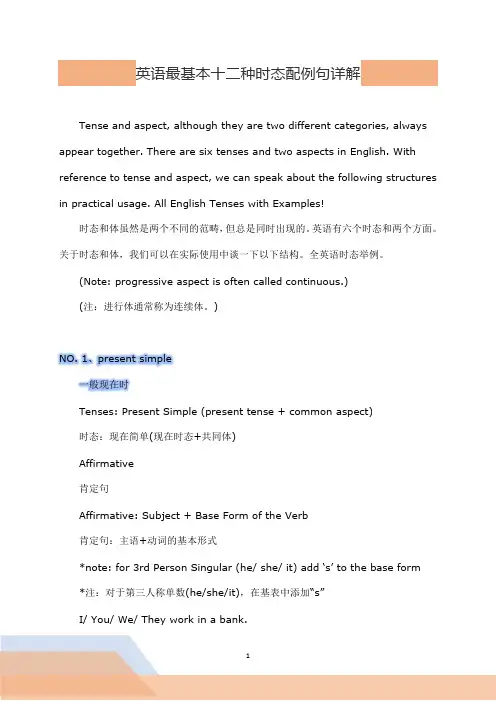
英语最基本十二种时态配例句详解Tense and aspect, although they are two different categories, always appear together. There are six tenses and two aspects in English. With reference to tense and aspect, we can speak about the following structures in practical usage. All English Tenses with Examples!时态和体虽然是两个不同的范畴,但总是同时出现的。
英语有六个时态和两个方面。
关于时态和体,我们可以在实际使用中谈一下以下结构。
全英语时态举例。
(Note: progressive aspect is often called continuous.)(注:进行体通常称为连续体。
)NO. 1、present simple一般现在时Tenses: Present Simple (present tense + common aspect)时态:现在简单(现在时态+共同体)Affirmative肯定句Affirmative: Subject + Base Form of the Verb肯定句:主语+动词的基本形式*note: for 3rd Person Singular (he/ she/ it) add ‘s’ to the base form*注:对于第三人称单数(he/she/it),在基表中添加“s”I/ You/ We/ They work in a bank.我/你/我们/他们在银行工作。
He/ She works in a bank.他/她在银行工作。
Negative否定句Negative: Subject + don’t/ doesn’t + Base Form of the Verb动词:主语+don’t/ doesn’t +动词的基本形式I/ You/ We/ They don’t (do not) work.我/你/我们/他们不工作。
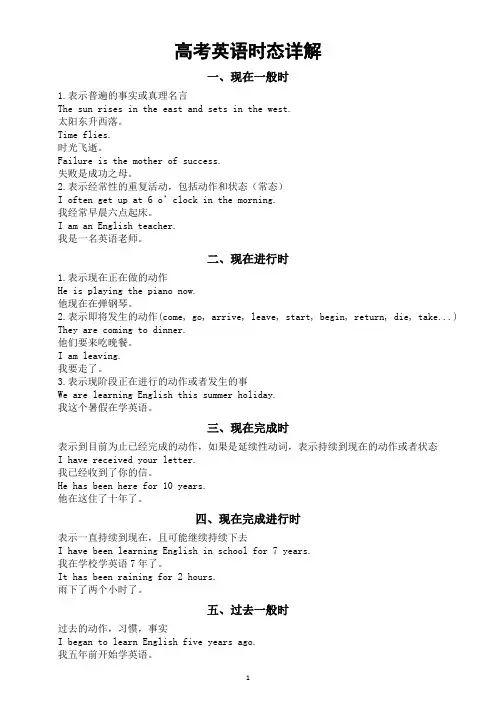
高考英语时态详解一、现在一般时1.表示普遍的事实或真理名言The sun rises in the east and sets in the west.太阳东升西落。
Time flies.时光飞逝。
Failure is the mother of success.失败是成功之母。
2.表示经常性的重复活动,包括动作和状态(常态)I often get up at 6 o’clock in the morning.我经常早晨六点起床。
I am an English teacher.我是一名英语老师。
二、现在进行时1.表示现在正在做的动作He is playing the piano now.他现在在弹钢琴。
2.表示即将发生的动作(come, go, arrive, leave, start, begin, return, die, take...) They are coming to dinner.他们要来吃晚餐。
I am leaving.我要走了。
3.表示现阶段正在进行的动作或者发生的事We are learning English this summer holiday.我这个暑假在学英语。
三、现在完成时表示到目前为止已经完成的动作,如果是延续性动词,表示持续到现在的动作或者状态I have received your letter.我已经收到了你的信。
He has been here for 10 years.他在这住了十年了。
四、现在完成进行时表示一直持续到现在,且可能继续持续下去I have been learning English in school for 7 years.我在学校学英语7年了。
It has been raining for 2 hours.雨下了两个小时了。
五、过去一般时过去的动作,习惯,事实I began to learn English five years ago.我五年前开始学英语。
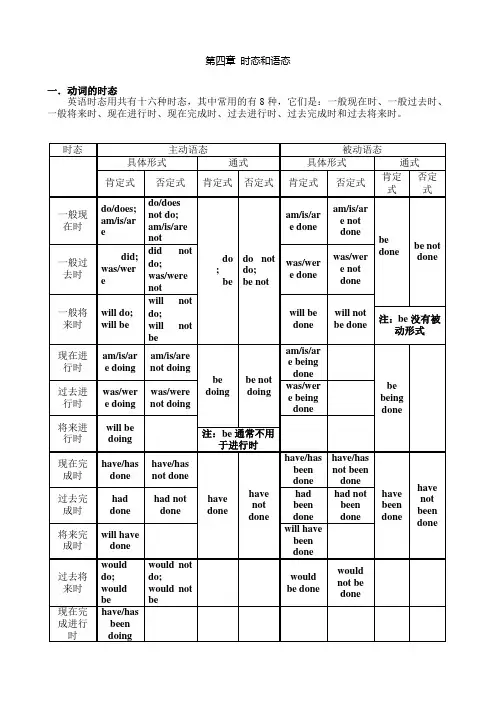
第四章时态和语态一.动词的时态英语时态用共有十六种时态,其中常用的有8种,它们是:一般现在时、一般过去时、一般将来时、现在进行时、现在完成时、过去进行时、过去完成时和过去将来时。
一. 一般现在时.1.构成. be动词:am is are ; 其他动词用动词原形,当主语是第三人称单数时要在谓语动词后加“s”,其变化规则与名词变复数一致。
2.用法. 1). 经常性或习惯性的动作,常与表示频度的时间状语连用。
如usually, always, often, seldom, never, every...,eg. I leave home for school at 7 every morning.I don’t leave home for school at 7 every morning.Do I leave home for school at 7 every morning?He usually gets up early.He doesn’t usually get up early.Does he usually get up early?2) 客观真理,客观存在,科学事实。
eg. The earth moves around the sun.The earth doesn’t move around the sun 否定句Does the earth move around the sun? 疑问句Shanghai lies in the east of China.Shanghai doesn’t lie in the east of China 否定句Does Shanghai lie in the east of China? 疑问句Water boils at 100 centigrade degrees.3) 表示格言或警句中eg. Pride goes before a fall.注意. 此用法如果出现在宾语从句中,即使主句是过去时,从句谓语也要用一般现在时。
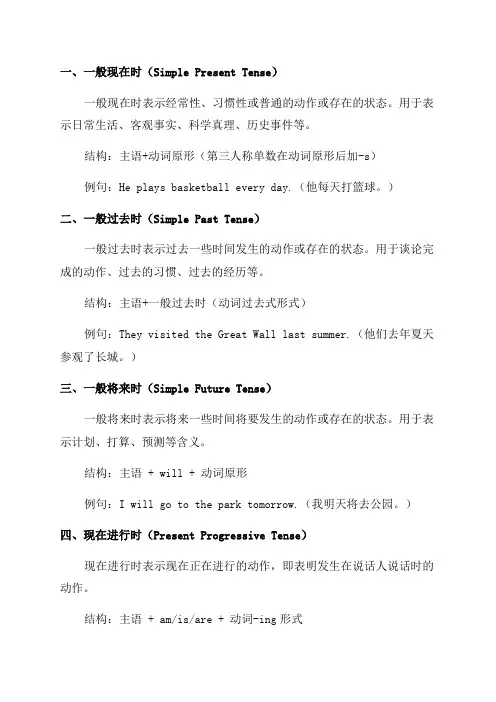
一、一般现在时(Simple Present Tense)一般现在时表示经常性、习惯性或普通的动作或存在的状态。
用于表示日常生活、客观事实、科学真理、历史事件等。
结构:主语+动词原形(第三人称单数在动词原形后加-s)例句:He plays basketball every day.(他每天打篮球。
)二、一般过去时(Simple Past Tense)一般过去时表示过去一些时间发生的动作或存在的状态。
用于谈论完成的动作、过去的习惯、过去的经历等。
结构:主语+一般过去时(动词过去式形式)例句:They visited the Great Wall last summer.(他们去年夏天参观了长城。
)三、一般将来时(Simple Future Tense)一般将来时表示将来一些时间将要发生的动作或存在的状态。
用于表示计划、打算、预测等含义。
结构:主语 + will + 动词原形例句:I will go to the park tomorrow.(我明天将去公园。
)四、现在进行时(Present Progressive Tense)现在进行时表示现在正在进行的动作,即表明发生在说话人说话时的动作。
结构:主语 + am/is/are + 动词-ing形式例句:She is reading a book right now.(她正在看书。
)五、过去进行时(Past Progressive Tense)过去进行时表示过去一些时间正在进行的动作,即已经开始但还没有结束的动作。
结构:主语 + was/were + 动词-ing形式例句:They were playing soccer at 4 o'clock yesterday.(他们昨天4点在踢足球。
)六、将来进行时(Future Progressive Tense)将来进行时表示将来一些时间正在进行的动作,即将来一些时刻正在进行的动作。
结构:主语 + will be + 动词-ing形式七、现在完成时(Present Perfect Tense)现在完成时表示过去发生的事情对现在造成的影响、持续到现在或者可能会再次发生的动作。
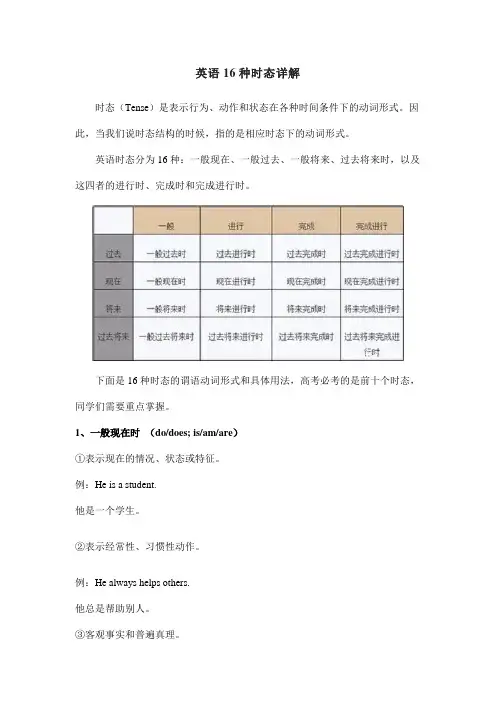
英语16种时态详解时态(Tense)是表示行为、动作和状态在各种时间条件下的动词形式。
因此,当我们说时态结构的时候,指的是相应时态下的动词形式。
英语时态分为16种:一般现在、一般过去、一般将来、过去将来时,以及这四者的进行时、完成时和完成进行时。
下面是16种时态的谓语动词形式和具体用法,高考必考的是前十个时态,同学们需要重点掌握。
1、一般现在时(do/does; is/am/are)①表示现在的情况、状态或特征。
例:He is a student.他是一个学生。
②表示经常性、习惯性动作。
例:He always helps others.他总是帮助别人。
③客观事实和普遍真理。
例:The earth moves the sun.地球绕着太阳转。
④表示一个按规定、计划或安排要发生的动作。
仅限于某些表示“来、去、动、停、开始、结束、继续”等的动词,可以与表示未来时间的状语搭配使用。
常见的用法是:飞机、火车、轮船、汽车等定期定点运行的交通方式。
例:The next train leaves at 3 o'clock this afternoon.下一趟火车今天下午3点开车。
⑤在时间、条件和让步状语从句中经常用一般现在(有时也用现在完成时)表示将的来事情。
(即:主将从现原则)例:I will call you as soon as I arrive at the airport.我一到机场就会给你打电话。
When you have finished the report, I will have waited for about 3 hours.等你完成这份报告的时候,我就已经等了将近3个小时了。
2、现在进行时(am/is/are doing)①表示此时此刻正在发生的事情。
例:He is listning to the music now.他现在正在听音乐。
②表示目前一段时间内一直在做的事情,但不一定此时此刻正在做。
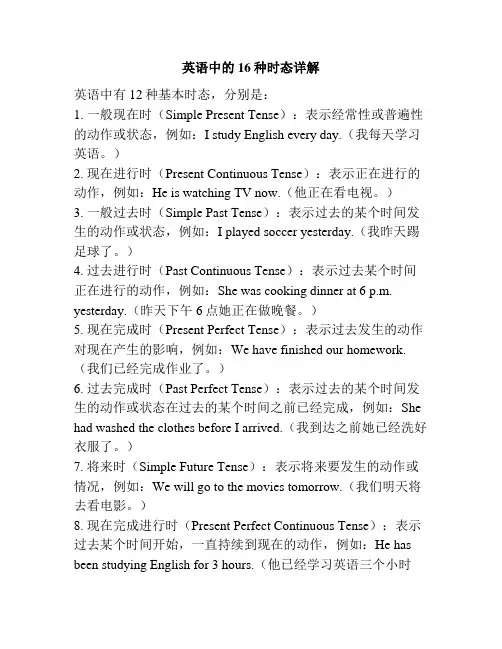
英语中的16种时态详解英语中有12种基本时态,分别是:1. 一般现在时(Simple Present Tense):表示经常性或普遍性的动作或状态,例如:I study English every day.(我每天学习英语。
)2. 现在进行时(Present Continuous Tense):表示正在进行的动作,例如:He is watching TV now.(他正在看电视。
)3. 一般过去时(Simple Past Tense):表示过去的某个时间发生的动作或状态,例如:I played soccer yesterday.(我昨天踢足球了。
)4. 过去进行时(Past Continuous Tense):表示过去某个时间正在进行的动作,例如:She was cooking dinner at 6 p.m. yesterday.(昨天下午6点她正在做晚餐。
)5. 现在完成时(Present Perfect Tense):表示过去发生的动作对现在产生的影响,例如:We have finished our homework.(我们已经完成作业了。
)6. 过去完成时(Past Perfect Tense):表示过去的某个时间发生的动作或状态在过去的某个时间之前已经完成,例如:She had washed the clothes before I arrived.(我到达之前她已经洗好衣服了。
)7. 将来时(Simple Future Tense):表示将来要发生的动作或情况,例如:We will go to the movies tomorrow.(我们明天将去看电影。
)8. 现在完成进行时(Present Perfect Continuous Tense):表示过去某个时间开始,一直持续到现在的动作,例如:He has been studying English for 3 hours.(他已经学习英语三个小时了。
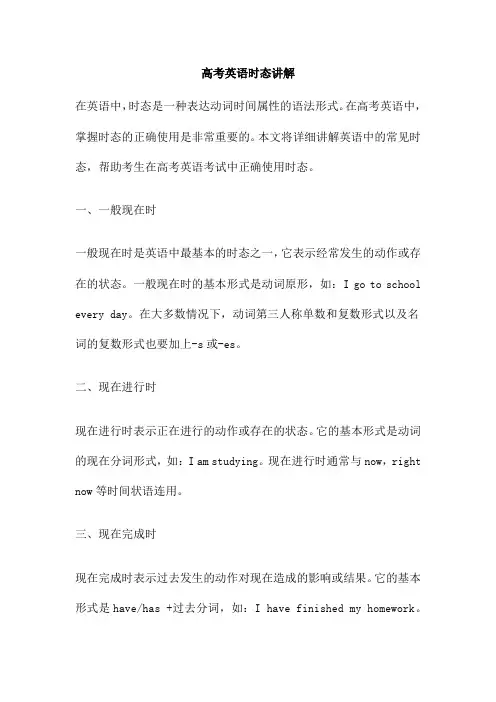
高考英语时态讲解在英语中,时态是一种表达动词时间属性的语法形式。
在高考英语中,掌握时态的正确使用是非常重要的。
本文将详细讲解英语中的常见时态,帮助考生在高考英语考试中正确使用时态。
一、一般现在时一般现在时是英语中最基本的时态之一,它表示经常发生的动作或存在的状态。
一般现在时的基本形式是动词原形,如:I go to school every day。
在大多数情况下,动词第三人称单数和复数形式以及名词的复数形式也要加上-s或-es。
二、现在进行时现在进行时表示正在进行的动作或存在的状态。
它的基本形式是动词的现在分词形式,如:I am studying。
现在进行时通常与now,right now等时间状语连用。
三、现在完成时现在完成时表示过去发生的动作对现在造成的影响或结果。
它的基本形式是have/has +过去分词,如:I have finished my homework。
现在完成时通常与already,yet等副词连用。
四、一般过去时一般过去时表示过去发生的动作或存在的状态。
它的基本形式是动词的过去式,如:I went to the park yesterday。
在大多数情况下,动词第三人称单数和复数形式以及名词的复数形式也要加上-ed或-d。
五、过去进行时过去进行时表示过去正在进行的动作或存在的状态。
它的基本形式是was/were +现在分词,如:I was studying at this time yesterday。
过去进行时通常与at this time yesterday等时间状语连用。
六、过去完成时过去完成时表示过去的过去发生的动作对过去造成的影响或结果。
它的基本形式是had +过去分词,如:I had finished my homework before dinner。
过去完成时通常与already,yet等副词连用。
七、一般将来时一般将来时表示将来要发生的动作或存在的状态。
它的基本形式是will +动词原形,如:I will go to school tomorrow。
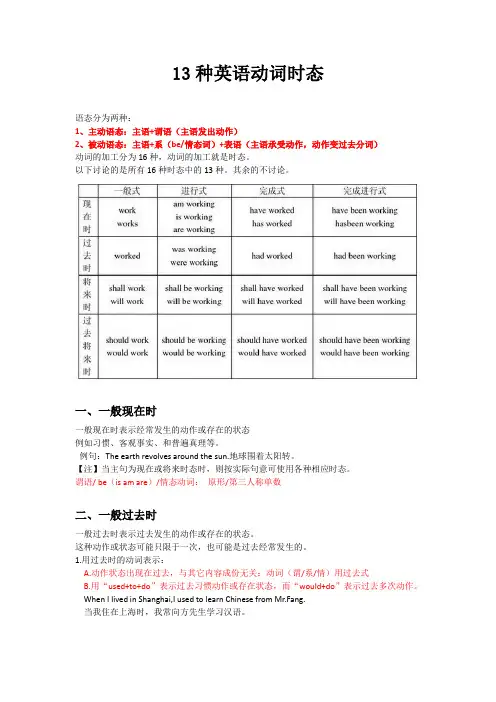
13种英语动词时态语态分为两种:1、主动语态:主语+谓语(主语发出动作)2、被动语态:主语+系(be/情态词)+表语(主语承受动作,动作变过去分词)动词的加工分为16种,动词的加工就是时态。
以下讨论的是所有16种时态中的13种。
其余的不讨论。
一、一般现在时一般现在时表示经常发生的动作或存在的状态例如习惯、客观事实、和普遍真理等。
例句:The earth revolves around the sun.地球围着太阳转。
【注】当主句为现在或将来时态时,则按实际句意可使用各种相应时态。
谓语/ be(is am are)/情态动词:原形/第三人称单数二、一般过去时一般过去时表示过去发生的动作或存在的状态。
这种动作或状态可能只限于一次,也可能是过去经常发生的。
1.用过去时的动词表示:A.动作状态出现在过去,与其它内容成份无关:动词(谓/系/情)用过去式B.用“used+to+do”表示过去习惯动作或存在状态,而“would+do”表示过去多次动作。
When I lived in Shanghai,I used to learn Chinese from Mr.Fang.当我住在上海时,我常向方先生学习汉语。
三、一般将来时一般将来时表示将来发生的动作或存在的状态(动作、状态发生在将来):will/shall+动词(谓/系/情)原形This afternoon we shall go to the net friend club.今天下午我们将去网友俱乐部。
【注】will/shall的用法:1. 【注】主将从现:在以when,if等连接的时间或条件状语从句内,要用现在时态替代将来时:I shall give you the book when I see you tomorrow.明天见到你时,我就将书交给你。
2.将来时还可以用来表示一种倾向或一种固有的特性:Without air and water a living thing will die.没有空气和水,生物便会死亡。
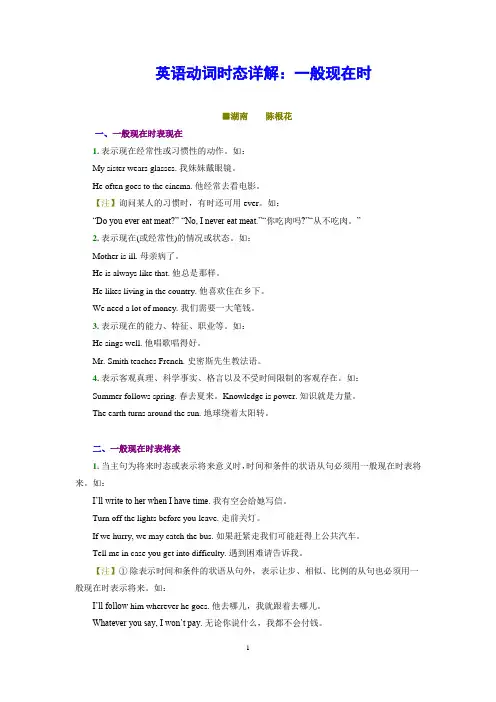
英语动词时态详解:一般现在时■湖南陈根花一、一般现在时表现在1.表示现在经常性或习惯性的动作。
如:My sister wears glasses. 我妹妹戴眼镜。
He often goes to the cinema. 他经常去看电影。
【注】询问某人的习惯时,有时还可用ever。
如:“Do you ever eat meat?” “No, I never eat meat.”“你吃肉吗?”“从不吃肉。
”2.表示现在(或经常性)的情况或状态。
如:Mother is ill. 母亲病了。
He is always like that. 他总是那样。
He likes living in the country. 他喜欢住在乡下。
We need a lot of money. 我们需要一大笔钱。
3.表示现在的能力、特征、职业等。
如:He sings well. 他唱歌唱得好。
Mr. Smith teaches French. 史密斯先生教法语。
4.表示客观真理、科学事实、格言以及不受时间限制的客观存在。
如:Summer follows spring. 春去夏来。
Knowledge is power. 知识就是力量。
The earth turns around the sun. 地球绕着太阳转。
二、一般现在时表将来1.当主句为将来时态或表示将来意义时,时间和条件的状语从句必须用一般现在时表将来。
如:I‟ll write to her when I have time.我有空会给她写信。
Turn off the lights before you leave. 走前关灯。
If we hurry, we may catch the bus. 如果赶紧走我们可能赶得上公共汽车。
Tell me in case you get into difficulty. 遇到困难请告诉我。
【注】①除表示时间和条件的状语从句外,表示让步、相似、比例的从句也必须用一般现在时表示将来。
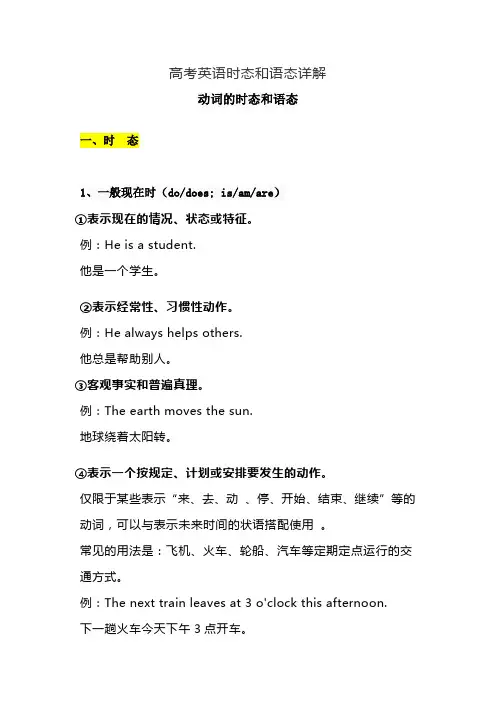
高考英语时态和语态详解动词的时态和语态一、时态1、一般现在时(do/does; is/am/are)①表示现在的情况、状态或特征。
例:He is a student.他是一个学生。
②表示经常性、习惯性动作。
例:He always helps others.他总是帮助别人。
③客观事实和普遍真理。
例:The earth moves the sun.地球绕着太阳转。
④表示一个按规定、计划或安排要发生的动作。
仅限于某些表示“来、去、动、停、开始、结束、继续”等的动词,可以与表示未来时间的状语搭配使用。
常见的用法是:飞机、火车、轮船、汽车等定期定点运行的交通方式。
例:The next train leaves at 3 o'clock this afternoon.下一趟火车今天下午3点开车。
⑤在时间、条件和让步状语从句中经常用一般现在(有时也用现在完成时)表示将的来事情。
(即:主将从现原则)例:I will call you as soon as I arrive at the airport.我一到机场就会给你打电话。
When you have finished the report, I will have waited for about 3 hours.等你完成这份报告的时候,我就已经等了将近3个小时了。
2、现在进行时(am/is/are doing)①表示此时此刻正在发生的事情。
例:He is listning to the music now.他现在正在听音乐。
②表示目前一段时间内一直在做的事情,但不一定此时此刻正在做。
例:I am studying computer this term.这个学期我一直在学习计算机。
③现在进行时可以表示将来的含义。
瞬时动词的进行一定表将来。
例:I am leaving.我要离开了。
持续动词的进行只有有将来的时间状语或有将来语境中才表将来。
例:I am travelling next month.下个月我要去旅行。
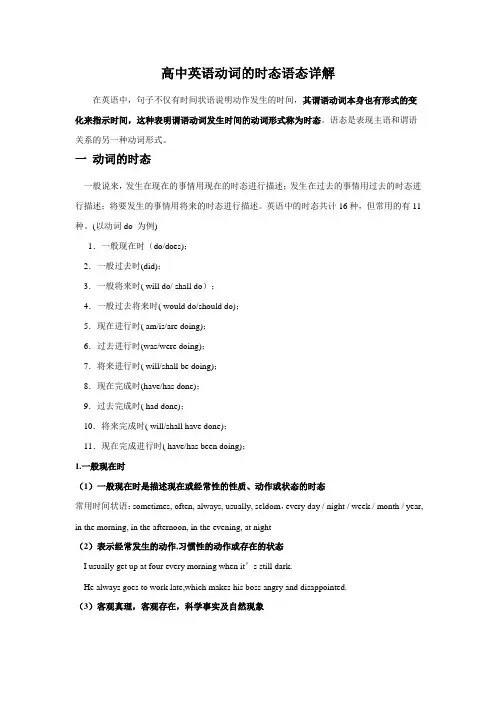
高中英语动词的时态语态详解在英语中,句子不仅有时间状语说明动作发生的时间,其谓语动词本身也有形式的变化来指示时间,这种表明谓语动词发生时间的动词形式称为时态。
语态是表现主语和谓语关系的另一种动词形式。
一动词的时态一般说来,发生在现在的事情用现在的时态进行描述;发生在过去的事情用过去的时态进行描述;将要发生的事情用将来的时态进行描述。
英语中的时态共计16种,但常用的有11种。
(以动词do 为例)1.一般现在时(do/does);2.一般过去时(did);3.一般将来时( will do/ shall do);4.一般过去将来时( would do/should do);5.现在进行时( am/is/are doing);6.过去进行时(was/were doing);7.将来进行时( will/shall be doing);8.现在完成时(have/has done);9.过去完成时( had done);10.将来完成时( will/shall have done);11.现在完成进行时( have/has been doing);1.一般现在时(1)一般现在时是描述现在或经常性的性质、动作或状态的时态常用时间状语:sometimes, often, always, usually, seldom,every day / night / week / month / year, in the morning, in the afternoon, in the evening, at night(2)表示经常发生的动作,习惯性的动作或存在的状态I usually get up at four every morning when it’s still dark.He always goes to work late,which makes his boss angry and disappointed.(3)客观真理,客观存在,科学事实及自然现象The sun rises in the east and sets in the west every day.The man who has never been to the Great Wall is not a real man.Trees turn green in spring. Liquid turns into gas when it is hot enough.(4)表示格言或警句中Pride goes before a fall.Knowledge is power.Practice makes perfect.(5)一般现在时表将来表示已经计划、安排好了或时间表上所安排,并且一定要做的事情。
千里之行,始于足下。
小学英语语法—时态知识点详解时态是英语语法中的一个重要知识点,它用来表达动作或状态的时间关系。
英语时态包括一般现在时、一般过去时、一般将来时、现在进行时、过去进行时、过去将来时等。
接下来,我将就这几个常用的时态进行详细的解释和知识点总结。
一、一般现在时一般现在时表示经常性、习惯性或普遍真理的动作或状态。
它一般由动词原形构成,但第三人称单数要在动词原形后加-s或-es。
例如:I read a book every day.(我每天都读书。
)He likes to play basketball.(他喜欢打篮球。
)二、一般过去时一般过去时表示过去发生的或已经结束的动作或状态。
它一般由动词的过去式构成,但特殊疑问句和否定句要借助助动词did。
例如:I went to the park yesterday.(我昨天去了公园。
)Did you watch the movie last night?(你昨晚看电影了吗?)三、一般将来时一般将来时表示将来发生的动作或状态。
它一般由助动词will或begoing to构成。
例如:I will visit my grandparents tomorrow.(我明天要去看望我的祖父母。
)She is going to have a party next week.(她下周要开个派对。
)第1页/共2页锲而不舍,金石可镂。
四、现在进行时现在进行时表示现在正在进行的动作。
它由be动词的现在分词形式(-ing 形式)构成。
例如:We are watching TV now.(我们正在看电视。
)She is studying in the library.(她正在图书馆学习。
)五、过去进行时过去进行时表示过去某个时间点或过去某段时间正在进行的动作。
它由be动词的过去分词形式(-ing形式)和过去式的be动词构成。
例如:They were playing football at 5 o’clock yesterday.(昨天五点他们在踢足球。
英语必考八大时态结构及用法详解一、一般现在时1. 概念:经常、反复发生的动作或行为及现在的某种状况.2. 基本结构:①is/am/are;②do/does否定形式:①am/is/are+not;②此时态的谓语动词若为行为动词,则在其前加don't,如主语为第三人称单数,则用doesn't,同时还原行为动词.3。
一般疑问句:①把is/am/are动词放于句首;②用助动词do提问,如主语为第三人称单数,则用does,同时,还原行为动词.4。
用法1) 经常性或习惯性的动作,常与表示频度的时间状语连用.例如:I leave home for school at 7 every morning。
每天早上我七点离开家.2) 客观真理,客观存在,科学事实。
例如:The earth moves around the sun。
地球绕太阳转动.Shanghai lies in the east ofChina. 上海位于中国东部.3) 表示格言或警句。
例如:Pride goes before a fall. 骄者必败。
注意:此用法如果出现在宾语从句中,即使主句是过去时,从句谓语也要用一般现在时。
例如:Columbus proved that the earth is round. 哥伦布证实了地球是圆的.4) 现在时刻的状态、能力、性格、个性.例如:I don’t want so much。
我不要那么多.Ann writes good English but does not speak well.安英语写得不错,讲的可不行.5) 一般现在时表示将来含义a。
下列动词come,go, arrive, leave, start,begin, return的一般现在时可以表示将来,主要用来表示在时间上已确定或安排好的事情。
例如:The train leaves at six tomorrow morning。
英语动词时态详解时态是英语语法中一个非常重要的概念,用于表示动作或状态发生的时间。
正确使用时态可以准确地表达过去、现在和将来的动作或状态。
本文将详细解释英语动词时态的不同形式和用法。
1. 一般现在时 (Simple Present Tense)一般现在时表示经常性动作、客观事实、永恒真理或现在的状态。
此时动词的原形直接用作谓语动词。
例如:- I go to school every day.(我每天去学校。
)- Water boils at 100 degrees Celsius.(水沸腾时温度是100摄氏度。
)2. 现在进行时 (Present Continuous Tense)现在进行时表示现在正在进行的动作,此时动词用“be动词+ Ving”的形式。
例如:- She is reading a book now.(她现在正在看书。
)- They are playing football in the park.(他们在公园里踢足球。
)3. 一般过去时 (Simple Past Tense)一般过去时表示过去某个时间发生的动作或状态,此时动词需要使用过去式。
例如:- He visited his grandparents last weekend.(他上个周末去看望了他的祖父母。
)- We lived in that house for ten years.(我们在那个房子里住了十年。
)4. 过去进行时 (Past Continuous Tense)过去进行时表示过去某一时间正在进行的动作,此时动词使用“were + Ving”的形式。
例如:- They were studying English when I called.(我打电话时,他们正在学习英语。
)- What were you doing at 9 p.m. last night?(昨晚9点你在干什么?)5. 一般将来时 (Simple Future Tense)一般将来时表示将来某个时间会发生的动作或状态,此时可以使用助动词“will”或“be going to”。
英语动词时态及用法详解英语动词时态是英语语法中的重要组成部分,它能够帮助我们准确地表达动作发生的时间和状态。
在这篇文章中,我们将详细探讨英语中常见的动词时态及其用法。
一、一般现在时一般现在时表示经常发生的动作、习惯性的行为、客观真理或普遍存在的情况。
其构成是主语+动词原形(当主语是第三人称单数时,动词要加“s”或“es”)。
例如:“I go to school every day”(我每天上学。
)“He likes playing football”(他喜欢踢足球。
)一般现在时常用于以下情况:1、表示日常习惯和规律,如“He gets up early every morning”(他每天早上都早起。
)2、表示客观事实和真理,例如“The earth moves around the sun”(地球绕着太阳转。
)3、表示永恒的状态,“Water boils at 100 degrees Celsius”(水在 100 摄氏度沸腾。
)二、一般过去时一般过去时表示过去某个时间发生的动作或存在的状态。
其构成是主语+动词的过去式。
比如:“I saw a movie yesterday”(我昨天看了一场电影。
)“She was happy last week”(她上周很开心。
)一般过去时的使用场景通常有:1、描述过去发生的一次性动作,“I met her at the party last night”(昨晚在派对上我遇见了她。
)2、讲述过去的习惯或状态,“When I was a child, I often played in the park”(当我还是个孩子的时候,我经常在公园玩。
)三、一般将来时一般将来时表示将来要发生的动作或存在的状态。
常见的构成方式有“will +动词原形”和“be going to +动词原形”。
像:“I will visit my grandparents next weekend”(下个周末我将去看望我的祖父母。
英语时态讲解1.一般现在时的应用(1)表示经常发生的动作或存在的状态.常用频度副sometimes,often,always,usually,seldom 以及时间副词every day/night/week/month/year,in the morning,in the afternoon,in the evening,at nig ht做状语.如:He often stays up late.他常熬夜。
We go home every month.我们每月都要回家。
I watch TV at night.我晚上看电视.(2)表示客观真理或永恒的状态.如:The earth travels round the sun.地球绕太阳旋转.Trees turn green in spring.春天树木变绿。
Liquid turns into gas when it is hot enough.足够热时,液体变为气体。
Practice makes perfect.熟能生巧。
(3)现阶段的状态。
常跟时间副词now连用。
如:He lives in Beijing now.他现在住在北京。
She is at home.她在家.They work in that factory.他们在那家工厂工作。
(4)习惯性的爱好或行为。
如:I like dancing while she likes singing。
我喜欢跳舞,而她喜欢唱歌。
We get up at six。
我们六点起床。
He studies very hard.他学习很刻苦。
(5)表示已经计划、安排好了或时间表上所安排,并且一定要做的事情。
用于这种句型的动词主要是瞬间动词:come,go,leave,arrive,begin,start,stop,close,open等.如:The train arrives at five past eight and leaves at ten past eight。
初中英语必考八大时态结构及用法详解一、一般现在时(Simple Present Tense):用法1:表示经常性的、重复性的动作或状态,相当于中文的“经常/总是/通常/偶尔……”。
例句:1. I often go hiking on weekends.(我经常在周末去远足。
)2. They usually play soccer after school.(他们放学后通常踢足球。
)用法2:表示客观真理、科学道理或普遍规律。
例句:1. Water boils at 100 degrees Celsius.(水沸腾时的温度是100摄氏度。
)2. The sun rises in the east and sets in the west.(太阳东升西落。
)二、一般过去时(Simple Past Tense):用法1:表示过去一些时间发生的动作或存在的状态。
例句:1. We went to the beach yesterday.(昨天我们去了海滩。
)2. They lived in London last year.(去年他们住在伦敦。
)用法2:表示过去经常性或重复性的动作。
例句:1. When I was young, I often played hide-and-seek with my friends.(我小时候经常和朋友们玩捉迷藏。
)2. He used to visit his grandparents every summer.(他过去每个夏天都去看望他的祖父母。
)三、一般将来时(Simple Future Tense):用法1:表示将来发生的动作或存在的状态。
例句:1. I will go to the movie tonight.(今晚我将去看电影。
)2. She is going to visit her grandparents next month.(她下个月打算去看望她的祖父母。
一、一般现在时(The Indefinite Present Tense).一般现在时表示经常性的或习惯性的动作、特征或状态。
常见的一般现在时主要有以下三种句式:1.肯定句式。
一般现在时肯定句式主要由动词原形表示,第三人称单数的谓语动词后要加词尾-s或-es。
动词be根据主语不同的人称有不同的形式,第一人称单数中动词be用am,第一人称复数、第二人称单数和复数以及第三人称复数中动词be用are的形式,第三人称单数中动词be用is,动词 have在主语是第三人称单数中变为has,其余情况均用原形have。
如:She is a worker.They are worker.He has a bike.We have a bike.I am the king of the world.2.疑问句式。
一般现在时变为疑问句时,一般在句首加助动词do或does的方式构成,第三人称单数时用does,其余情况都用do,主要动词一概不变,用原形;在以have或has为主要动词的句子中,可以直接将动词have或has提前放于句首,也可以在句首加动词do或does构成,have或has一律用原形have。
如:Do you work?Does he work?Has she a cake?Does she have a cake?其简略回答形式用“Yes+主语+动词”或“No+主语+动词+not”。
如:Yes, I do.No, he does not.Yes, she hasNo, she has not.3.否定句式。
一般现在时的否定句式在动词前加do/does not的形式构成。
如:She does not work.They do not have a cake.此外,一般现在时的主要动词在第三人称单数时,要在词尾加-s或-es。
其规则如下:以ch sh x s 或o结尾的动词加-es,以y结尾的动词要先把y改写成i 后,再加-es;其余情况一般直接加-s即可。
二、现在进行时(The PresentContinuous Tense).现在进行时一般用在表示现在或现阶段正在进行或发生的动作,或即将发生的动作,多指按计划或安排要进行的动作和表示反复出现的习惯性动作(如 always总是、 continuously不断地等词)。
现在进行时一般可以从句中找到时间标志词,如now, these days at the moment等词语,就必须用现在进行时态来表示。
其构成形式为主语+be+现在分词+其他。
现在进行时态的三种句式简要介绍如下:1.肯定句式。
现在进行时的肯定句式一般由“be+现在分词”构成。
同样,be 在不同的人称形式下,有不同的表现形式。
在主语是第一人称单数中动词be用am,第一人称复数、第二人称单数和复数以及第三人称复数中动词be用are的形式,第三人称单数中动词be用is,如:They are working on the farm now.I’m leaving for BeiJing tomorrow.2.否定句式。
现在进行时的否定句式一般由“be+not+现在分词”构成。
动词be的用法与在肯定句式情况下是相似的。
如:He is not looking.3.疑问句式。
现在进行时的疑问句式一般把动词be放于句首构成:“be+主语+现在分词+其他?”,动词be在不同人称形式下的用法与在肯定句式情况下是相似。
如:Is he always saying that?回答时可以用“Yes+主语+动词”或“No+主语+动词+not”。
如:Yes, she is.No, she is not.同样,动词的现在分词的构成也是有规律的,一般情况在词尾直接加-ing来表示;在以不发音的e结尾的词,要先把e去掉,再加上-ing,如 write的现在分词是writing;在以重读闭音节结尾只有一个辅音字母时,应先双写此辅音字母,再加-ing,如begin的现在分词是 beginning。
三、一般将来时(The Future indefinite tense).一般将来时多用于口语中,常表示要去做的事或可能要发生的事。
一般将来时由be going to +动词不定式构成。
其用法简单列举如下:1.肯定句式。
一般将来时的肯定句式由“be going to +动词不定式”构成。
be在不同的人称形式下,其形式也是不同的:主语是第一人称单数用am、第二人称单数用are,第三人称单数用is,其余情况下均用are。
如:We are going to visit guiyang.2.否定句式。
一般将来时的否定句式由“be not going to +动词不定式”构成。
be在不同的人称形式下,变化与在肯定句式下相似。
如:We are not going to stay with him.3.疑问句式。
一般将来时的疑问句式把be放于句首:“be+主语+ going to+其他?”构成,be在不同的人称形式下,变化与在肯定句式下相似。
如:Is he going to talk with her teacher?其回答形式为“Yes+主语+动词”或“No+主语+动词+not”。
如:Yes, he is.No, he is not.此外,动词不定式是无规则可循的,需要在学习中多积累才能正确牢记和运用。
四、一般过去时(The past Indefinite tense).一般过去时表示过去某时发生的动作或情况。
一般过去时用动词过去式表示。
动词过去式按其构成形式有规则和不规则变化两种情况。
规则动词的过去式一般直接在词尾加-ed,即:动词原形+ ed;无规则变化的需要边学边记。
其用法简单列举如下:1.肯定句式。
一般过去时的肯定句式由“主语+动词过去式+其他”构成。
Be作为主要动词应用时,在主语是第一人称单数和第三人称单数的情况下,用过去式was;其余人称情况下,用过去式were。
如:She worked here .She was here .2.否定句式。
一般过去时的否定句式由:“主语+动词过去式+ not+其他”构成。
be在不同的人称形式下,变化与在肯定句式下相似。
如:I did not work here .We were not here.3.疑问句式。
一般过去时的疑问句式把动词be放在句首或在句首加助动词did 构成。
be在不同的人称形式下,变化与在肯定句式下相似。
如:Did you work here?Was he here?其简略回答形式用“Yes+主语+动词”或“No+主语+动词+not”。
如:Yes, I did .No, I did not.五、过去进行时(The past Continuous tense).过去进行时态表示的是过去某个时间正在进行或发生的动作。
其构成形式为:“主语+was/were+现在分词”构成。
一般情况下,过去进行时态有一些提示性词语,如at this time yesterday , at that time,或由when引导的时间状语从句。
过去进行时态用法简单列举如下:1.肯定句式。
过去进行时态的肯定句式一般体现为:“主语+was/were+现在分词+其他”构成。
其中凡是在主语是单数人称情况下一律用was,复数人称情况下用were。
如:I was working.We were working.2. 否定句式。
过去进行时态的否定句式构成形式为“主语+was/were+ not+现在分词+其他”构成。
was/were的用法与肯定句式的用法相似。
如:I was not working.We were not working.3.疑问句式。
过去进行时态的疑问句式只需把was/were提前放在句首即可。
其构成形式为“was/were+主语+ not+现在分词+其他?”构成。
如;Was she working?Were they working?其简略回答形式用“Yes+主语+动词”或“No+主语+动词+not”。
如:Yes, she was .No, she was not.其中,过去进行时态的现在分词构成规则与现在进行时态的过去分词是相同的。
六、现在完成时(The Present Perfect tense).现在完成时表示一个过去发生而对现在情况有影响的动作和从过去某时继续到现在的动作或状态。
其构成形式为“主语+have(has)+过去分词+其他”。
现在完成时用法简单列举如下:1. 肯定句式。
现在完成时的肯定句式一般表现为“主语+ have(has)+过去分词+其他”。
have(has)的用法为,在主语是第三人称单数的情况下,用has;其余情况用have。
如:He has been to Japan before.We have written it.2. 否定句式。
现在完成时的否定句式由“主语+ have(has)+ not+过去分词+其他”构成。
其中have(has)的用法与肯定句式下的用法相似。
如:They have not written it.He has not written it.3.疑问句式。
现在完成时的疑问句式只需把助动词have(has)提前放在句首即可。
句式为“Have(has)+主语+过去分词+其他?”构成。
其中have(has)的用法与肯定句式下的用法相似。
如:Has she written it?Have you written it?其简略回答形式用“Yes+主语+动词”或“No+主语+动词+not”。
如:Yes, she has .No, she has not.此外,现在完成时的过去分词与它的过式相同,不规则的动词的过去分词需要在日常学习中边学边记。
值得强调的是,现在完成时与过去式是有既区别又有联系的。
一般情况下,当有一个表示到现在为止这段时间的状语,用already, yet, just as yet, ever, never等这类副词作状语,或一件已经发生的事,不考虑它是什么时候发生的,而主要考虑对现在的影响时,多用现在完成时。
七、一般过去将来时(The Simple past future tense).一般过去将来时往往表示从过去某时看将要发生的动作或存在的状态和过去习惯性的动作,说明在什么情况下往往如此。
一般过去将来时句式由should或would+动词原形构成。
总体来说,一般过去将来时主要有以下两种用法:1.在表示过去某时看来将要发生的动作或存在的状态。
其构成形式为“should 或would+动词原形”。
一般情况下should或would的用法是在主语是第一人称的句式下,常用should;其他人称的情况下常用would。